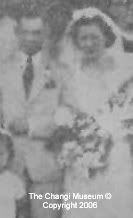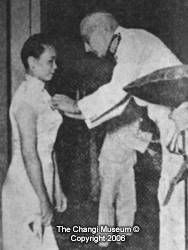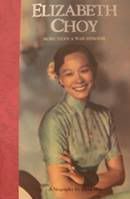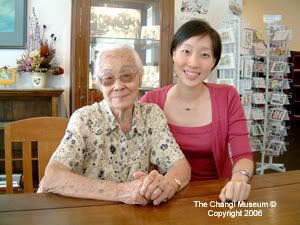Wednesday, November 1, 2006
Mr and Mrs Choy on their wedding day After Singapore fell to the Japanese on 15th February 1942, Elizabeth Choy and her husband found themselves without jobs. Subjects in school were no longer in English, hence Mrs. Choy had to stop teaching and the Borneo Co. where Mr. Choy worked at, ceased to exist once the Japanese took over Singapore. However, doctors and nurses who knew the couple, urged them to help run a canteen stall in the Miyako Hospital (also known as the Woodbridge Hospital) to help provide basic essentials to everyone. The former YMCA building Elizabeth Choy receiving the OBE from Governor Sir Patrick McKerron. Elizabeth Choy with her medals Elizabeth Choy - More Than A War Heroine. A biography by Zhou Mei. Elizabeth Choy with her grand-daughter at the Changi Museum on 30th September 2003 The Changi Museum extends their heartfelt condolences to the Choy family.
After her Senior Cambridge examination, Elizabeth Yong decided to work instead of pursuing her education further, to provide for her younger siblings. She chose to enter the teaching profession and began doing so at St. Margaret's School for two years before being offered a teaching position at St. Andrew's School.
Before the outbreak of the Second World War, Elizabeth Yong married Choy Khun Heng, who was the oldest son of an old lady who was her classmate's guardian. The old lady took a liking for Ms Yong and asked her to marry her eldest son. 10 years after first meeting with her, she finally tied the knot with Mr Choy on 16th August 1941.
They ran the stall together with the primary aim of providing fundamental necessities to the public however it didn't take long before it became a central area for the exchange of messages, medicine and food to the prisoners of Changi.
After the 'Double Tenth' incident (where the Japanese arrested 57 prisoners for possible involvement with a successful sabotage mission that destroyed 6 Japanese oil tankers at Keppel Harbour), Elizabeth Choy and her husband were detained in the Japanese Kempetai (military police) headquarters, the former YMCA building.
The three by four metres cell was to be her home with the other prisoners, for the next 193 days.
Mrs. Choy, along with the other 20 or so male prisoners, had to live in those squalid conditions with very little food, ventilation and clean water. They were also not allowed to talk or move from their cross-legged seating position. Although they were not allowed to speak, the prisoners continued to communicate with each other through the use of sign language which was taught by one of the fellow prisoners.
Mrs. Choy had been brutally treated during her internment. She was subjected to beatings by the Japanese officers and was even electrocuted in front of her husband. The Japanese tried to force her into giving out the names of informants or admitting that she was anti-Japanese. After 193 days, the Japanese finally released her from prison, after learning that they would never get the 'confession' that they wanted out of her. She was released the day after her husband was sentenced to 12 years of rigorous imprisonment on 25th May 1944.
After the war ended on 12 September 1945, she traced her husband's whereabouts to Outram Gaol and together with a British soldier, they freed him. Although he regained his freedom, Choy Khun Heng never fully regained his health.
After her ordeal, Mrs. Choy developed a fear of electricity and electrical appliances. She would even avoid turning on a simple switch at all costs. Despite having this lifelong fear as a result of the atrocities inflicted upon her during the war, when given the opportunity to identify the Japanese officer that tortured her, to be sentenced at the War Crimes Tribunal, she refused to provide any names stating that she condemned war and not the people who tortured her.
After the war, the Red Cross had offered the Choys to live in Britain since their house was in ruins and was heavily looted during the war. Only Mrs. Choy accepted the offer and she flew to Britain in 1946.
That same year, she and her husband were awarded the Order of the British Empire (OBE) for their efforts during the war. She only returned to Singapore just before Christmas Eve in 1949. It was only after her return that she received the medal at an official ceremony. 
The following year she helped set up the School for the Blind and served as the principal of the school. Elizabeth Choy, together with Mr. Ron Chandran-Dudley, secretary of the Disabled People's Association, made visits to the villages to convince skeptical parents of blind children to allow them to go to school. She retired from teaching in 1974.
By the time of her retirement, she had been awarded several medals not just for her bravery but also for her contribution to society. On top of the OBE, she also received the Order of the Star of Sarawak (OSS) from the Raja of Sarawak.
She received this in appreciation of her pre-war work as a volunteer nurse, where she helped many Sarawakians. The Bronze Cross (BC) from the Girl Guide movement in England (the movement's highest award), was also awarded to Mrs. Choy in recognition for her valour during the Japanese occupation. And lastly she received the Pingkat Bakti Setia (PBS) or the Long Service Teaching Award from Singapore. 
Secondly, a biography of Elizabeth Choy was released in 1995, written by Zhou Mei, entitled Elizabeth Choy - More Than A War Heroine. This followed by an exhibition two years later, by the National Museum entitled, Elizabeth Choy - A Woman Ahead of Her Time. 

________________________________________________________________